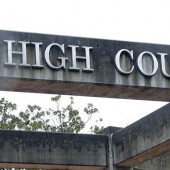Our website uses cookies so we can analyse our site usage and give you the best experience. Click "Accept" if you’re happy with this, or click "More" for information about cookies on our site, how to opt out, and how to disable cookies altogether.
We respect your Do Not Track preference.

The appellant, Arthur Taylor, sought access to his personal information held by the Department of Corrections, for the period 1 August 2014 – 5 September 2014. He was at the time a prisoner at Auckland Regional Prison, Albany. His request was broad, seeking:
… copies of all file notes, incident reports, email traffic other information of any kind in any form, that relates to me, is about myself or mentions refers to me in any way shape or form… [para 10]
Relevant information was provided by Corrections, but some information was withheld. Specifically, the Department withheld the names, positions and contact details of Corrections staff. A watermark also obscured the content of some of the documents.
Corrections’ view
The Department maintained that the details of the staff names could be withheld under s29(1)(a) of the Privacy Act, and that releasing the information would involve the unwarranted disclosure of the affairs of another person.
Privacy Commissioner complaint
Mr Taylor initially complained to the Privacy Commissioner. After investigating the complaint, the Commissioner took a somewhat different view to the Department. He formed the opinion that requirements of s29(1)(a) had not necessarily been met on the facts. It was not clear why the information needed to be withheld “in the absence of any specific argument why releasing this particular information would be unwarranted” [para 18].
Human Right Review Tribunal
The Human Rights Review Tribunal found in favour of the Department. Specifically, it found that the withheld information – the details of Corrections staff – was not in fact personal information about Mr Taylor, and so should not be disclosed under principle 6. The issue of the watermark was found to be trivial.
High Court appeal
Mr Taylor appealed the Tribunal’s decision to the High Court. Justice Gwyn heard the matter with two lay Tribunal members. The question before the Court was whether the redacted information was in fact personal information about Mr Taylor.
Defining personal information
Submissions focused in part on the scope of the term “personal information”. Counsel for the Department argued that the definition should be narrower rather than wider and should be consistent across all the privacy principles. The Court of Appeal case of Harder v Proceedings Commissioner was an illustrative example (Harder v Proceedings Commissioner [2000] NZLR 80 (CA)).
The Privacy Commissioner and the Director and the appellant favoured a wider interpretation of the term “personal information”.
The Commissioner’s submission [para 35] was that a wider definition of personal information was balanced and regulated by the application of the withholding grounds in the Act, see ss27-29. The Court rejected this argument, commenting [para 64]:
“It is no answer to the difficulty in fixing on a definition to say that recourse can be had to other mechanisms in the Act to calibrate privacy and other interests…”
Mixed information
The Commissioner and the Director submitted that the redacted information was “mixed information” about the staff members and Mr Taylor.
The Court did not accept that position [para 60]. There was no intermingling of information in any substantive sense:
“The information that is plainly Mr Taylor’s personal information merely appears on the same page as the redacted information (the personal information of the Corrections officers). The two are not intertwined and the material provided to Mr Taylor is not rendered unintelligible by reason of the redactions.”
Conclusion
The Court found that the names of Corrections staff appearing in Mr Taylor’s file was not personal information about him [para 66] and did not need to be disclosed under the Privacy Act. The information was not “about” Mr Taylor but was essentially administrative information.
It went on to note that because of that finding, it did not need to reach a view about whether any of the withholding grounds applied. There had been no interference with Mr Taylor’s privacy under the Privacy Act.
Read the Taylor v Chief Executive of the Department of Corrections [2019] NZHC 383 [4 March 2020] High Court decision here.
Image credit: High Court via RNZ
Back